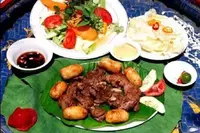The vietnamese

Vietnamese cuisine has been influenced by Chinese and Indian cuisines throughout its history, but it has managed to maintain its uniqueness and uniqueness, which manifests itself primarily in a stunningly harmonious combination of aromas and colors. Vietnamese cuisine is one of the Asian cuisines and, accordingly, adopts some of its traditions.
Of course, the basis of Vietnamese cuisine is grain products. And the most important of these is certainly the fig. Rice is served as a side dish to most Vietnamese dishes. Rice flour serves as a raw material for making rice noodles and rice paper. Rice noodles are one of the most popular Vietnamese dishes. As a rule, every day the average Vietnamese eat at least one serving of rice noodles, and most often not one. Rice paper is an integral part of the Vietnamese culinary tradition, because it goes to the manufacture of rolls, served with dipping sauce.
And yet rice is only a side dish. Fish and meat are used as the main dishes of Vietnamese cuisine. Thanks to the presence of the sea coast in Vietnam, as well as an extensive river system, the inhabitants of the country are generously provided with fish and all kinds of seafood. In the recipes of Vietnamese cuisine, in an extraordinary variety, there are products such as crabs, shrimp, squid, mussels and all only possible species of fish.
As for meat products, beef and pork are among the leaders. It should be noted that there is still not much meat in Vietnam. Most often, Vietnamese dishes contain finely and thinly chopped pieces of meat. Vietnamese recipes, especially in the salad section, often contain chicken, but eggs, oddly enough, are not often consumed by Vietnamese.
Vietnam is famous for its favorable climate and fertile lands, therefore, various vegetables and fruits are invariably included in the diet of Vietnamese. Of the vegetables, cabbage, onions, carrots, garlic, various types of peppers, tomatoes, cucumbers, celery, lettuce leaves, bamboo sprouts are the most common. Vegetables tend to be roasted and served alongside noodles and rice, as well as a separate side dish or salad.
Among fruits, mangoes, melons, lychees, pineapples and tangerines are the most common. Fruits in Vietnamese recipes are served as dessert or as an additive to the main dishes, to give them an extraordinary taste and aroma.
No less than rice, legumes are common in Vietnam. In particular, these are peas, beans and lentils. Separately, tofu is worth noting - soy cottage cheese, which is used as an ingredient in many national dishes. Quite often, pea pods and legume sprouts are found in Vietnamese recipes.
Peanuts are another necessary addition to Vietnamese cuisine. It is often ground into a paste and in this form is added to soups and noodle dishes, and a ready-made dish is sprinkled with it before serving. The same is done with sesame grains. Sesame oil is one of the most common foods in the Vietnamese culinary tradition. It gives dishes a unique aroma and completeness of the composition.
Vietnamese people are very sensitive to all kinds of sauces and seasonings. There are a lot of them in the Vietnamese tradition. This is a well-known soy sauce, as well as a fish sauce that is made from fermented fish. Herbs are an indispensable component of Vietnamese cuisine.
Cilantro, basil and mint are widespread here. Red and black ground peppers are often added to dishes as spices, as well as garlic, ginger, vinegar, lemon and lime juice.
Vietnamese cuisine appears before us so unusual. On the one hand, it is very similar to other culinary traditions of Asian cuisines, and, on the other hand, it is unusually original and unique.
 Español
Español Français
Français Português
Português Русский
Русский 简体中文
简体中文 繁體中文
繁體中文 日本語
日本語 한국어
한국어 العربية
العربية Türkçe
Türkçe Қазақ
Қазақ Deutsch
Deutsch Italiano
Italiano Українська
Українська
